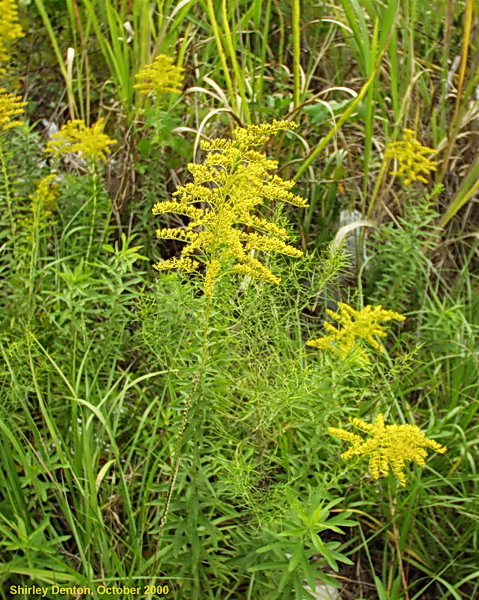Solidago fistulosa
| Solidago fistulosa | |
|---|---|

| |
| Photo by Shirley Denton (Copyrighted, use by photographer’s permission only), Nature Photography by Shirley Denton | |
| Scientific classification | |
| Kingdom: | Plantae |
| Division: | Magnoliophyta - Flowering plants |
| Class: | Magnoliopsida – Dicotyledons |
| Order: | Asterales |
| Family: | Asteraceae ⁄ Compositae |
| Genus: | Solidago |
| Species: | S. fistulosa |
| Binomial name | |
| Solidago fistulosa Mill. | |

| |
| Natural range of Solidago fistulosa from USDA NRCS Plants Database. | |
Common names: Pine barren goldenrod, Hairy pineywoods goldenrod
Contents
Taxonomic notes
Description
A description of Solidago fistulosa is provided in The Flora of North America.
Distribution
Found in the Coastal Plain from Louisiana to New Jersey, however, is primarily concentrated in the southeast coastal plain.[1]
Ecology
Habitat
In the Coastal Plain in Florida and Georgia, S. fistulosa occurs in wet hammocks, cabbage palm-slash pine hammocks, slash pine woodlands, lake margins, open ditches bordering swamps, shores of cypress ponds, thickets bordering cypress-gum depressions, floodplain woodlands, brackish marshes, and dried out cypress depressions. It also occurs in disturbed areas such as roadside depressions, black sandy peat of a logged over hillside bog, clear-cut sand pine scrub ridge, old pastures, and a drainage ditch bordering pine flatwoods. Soils include loamy sand, sandy loam, sandy peat, and clay.Cite error: Invalid <ref> tag;
refs with no name must have content
Associated species include Euthamia minor, Eupatorium, Xyris, Cladium, Rhynchospora fascicularis and Hypericum cistifolium.[2]
Phenology
S. fistulosa spreads by rhizomes along with sexual reproduction. It is a monecious species. It has been observed flowering in July and September through November and fruits in October.[2][3]
Fire ecology
S. fistulosa has been observed growing in a recently burned pineland bay forest and an annually burned pine forest.[2]
Pollination
The following Hymenoptera families and species were observed visiting flowers of Solidago fistulosa at Archbold Biological Station:[4]
Apidae: Apis mellifera
Colletidae: Colletes mandibularis, C. thysanellae
Halictidae: Augochlorella gratiosa, Halictus poeyi, Sphecodes heraclei
Megachilidae: Coelioxys sayi
Sphecidae: Anacrabro ocellatus, Tachytes validus
Vespidae: Eumenes smithii, Parancistrocerus salcularis rufulus, Polistes dorsalis hunteri, Zethus spinipes
Conservation, cultivation, and restoration
S. fistulosa is a perennial weed in blueberry plantations in North Carolina. It is tolerant of terbacil.[5]
Cultural use
Rubber can be made from the latex found in the leaves.[6]
Photo Gallery
References and notes
- ↑ [[1]]Native Florida Wildflowers. Accessed: March 17, 2016
- ↑ 2.0 2.1 2.2 Florida State University Robert K. Godfrey Herbarium database. URL: http://herbarium.bio.fsu.edu. Last accessed: November 2015. Collectors: Loran C. Anderson, Robt. Blaisdell, A.F. Clewell, Mark A. Garland, Robert K. Godfrey, G.G. Hedgcock, Lisa Keppner, Gary Knight, R. Komarek, Robert Kral, Robert L. Lazor, R.A. Norris, James D. Ray Jr., Paul L. Redfearn Jr., Annie Schmidt, J.C. Semple, R. Wunderlin. States and Counties: Florida: Baker, Bay, Duval, Franklin, Gulf, Highlands, Hillsborough, Jefferson, Lake, Leon, Levy, Liberty, Okaloosa, Putnam, Santa Rosa, Taylor, Volusia, Wakulla, Walton, Washington. Georgia: Grady, Thomas. Compiled by Tall Timbers Research Station and Land Conservancy.
- ↑ Nelson, G. PanFlora: Plant data for the eastern United States with emphasis on the Southeastern Coastal Plains, Florida, and the Florida Panhandle. www.gilnelson.com/PanFlora/ Accessed: 14 DEC 2016
- ↑ Deyrup, M.A. and N.D. 2015. Database of observations of Hymenoptera visitations to flowers of plants on Archbold Biological Station, Florida, USA.
- ↑ Andree, L. G. and J. M. Thomas (1983). "Metabolism of Terbacil in Strawberry (Fragaria × ananassa) and Goldenrod (Solidago fistulosa)." Weed Science 31(2): 221-225.
- ↑ [[2]]Accessed: March 16, 2016